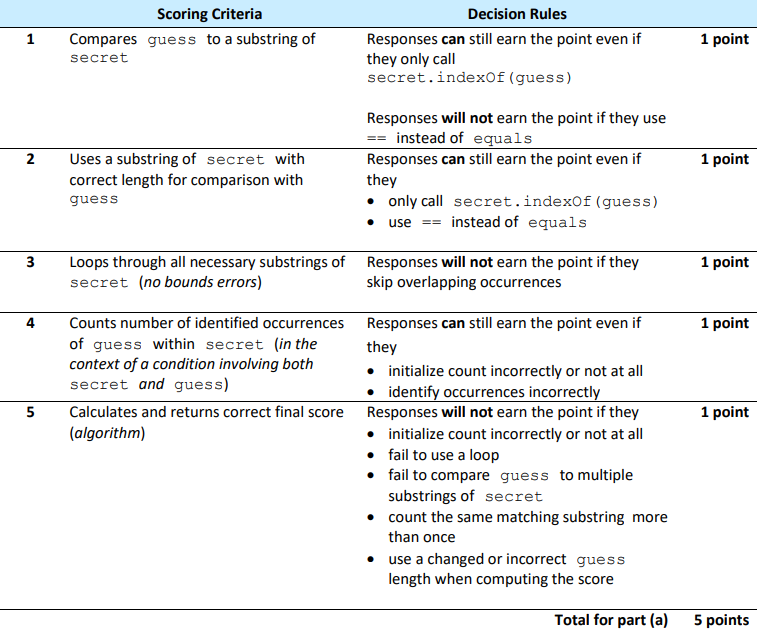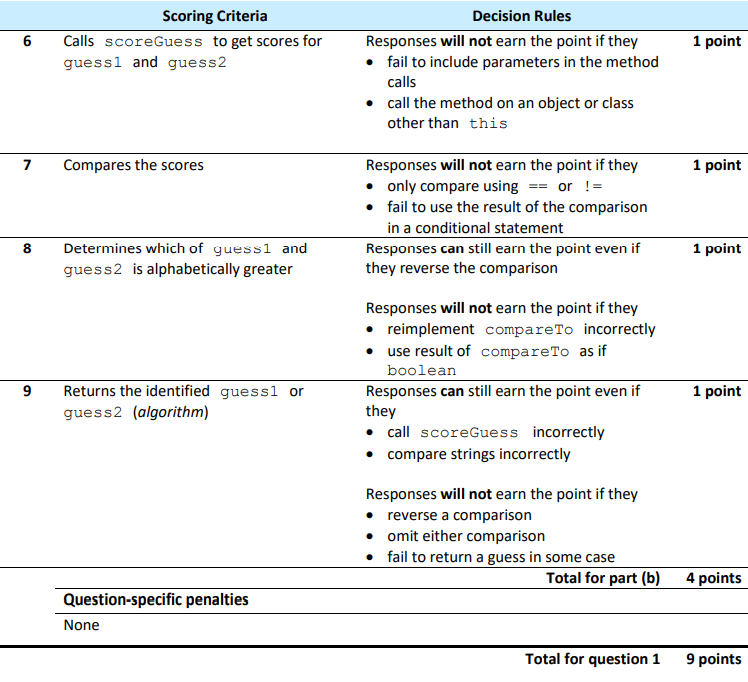public class CombinedTable
{
private SingleTable table1;
private SingleTable table2;
public CombinedTable(SingleTable tab1, SingleTable tab2)
{
table1 = tab1;
table2 = tab2;
}
public boolean canSeat(int n)
{
if (table1.getNumSeats() + table2.getNumSeats() - 2 >=n)
{
return true;
}
else
{
return false;
}
}
public double getDesireability()
{
if (table1.getHeight() == table2.getHeight())
{
return (table1.getViewQuality() +
table2.getViewQuality()) / 2;
}
else
{
return (table1.getViewQuality() +
table2.getViewQuality()) /2;
}
}
}
At the restaurant, customers can it at tables that are composed of 2 single tables pushed together. You will write a class “CombinedTable” to represent the result of combining two SingleTable objects, based on the following rules and examples in the chart that follows.
- A CombinedTable can seat a number of customers that is two fewer than the total number of seats in its two SingleTable objects (to account for the seats lost when the tables are pushed together)
- A CombinedTable has a desirability that depends on the views and heights of the two single tables. If the tables of a CombinedTable object are the same height, the desireability of the CombinedTable object is the average of the view qualities of the two single tables.
- If the two single tables of a CombinedTable object are not the same height, the desirability is decreased
Using classes in Java can be powerful and essential for building complex software systems, but it’s also easy to make mistakes, especially for beginners. Here are some common and simple mistakes that can be made when using classes in Java:
Misspelled Class Names: Java is case-sensitive, so if you misspell a class name when creating an object or referencing a class, it will result in a compilation error.
MyClass myclass = new Myclass(); // Incorrect
MyClass myClass = new MyClass(); // Correct
Not Importing Classes: If you forget to import a class that you want to use, you’ll encounter a compilation error. Import statements are necessary for using classes from different packages.
// Missing import statement
ArrayList<String> list = new ArrayList<String>(); // Compilation error
// Correct import statement
import java.util.ArrayList;
ArrayList<String> list = new ArrayList<String>(); // Correct
Access Modifiers: Using incorrect access modifiers (e.g., private, protected, public) can lead to issues with visibility and accessibility of class members. Make sure to use the appropriate access modifier for your class members.
public class MyClass {
private int myVariable; // Incorrect, should use protected/public if needed
}
- Java Example Using Classes: The question involves the WordMatch class, which stores a secret string and provides methods that compare other strings to the secret string. Here’s a simplified example:
public class WordMatch {
private String secret;
public WordMatch(String word) {
this.secret = word;
}
public int scoreGuess(String guess) {
// Implementation here...
}
public String findBetterGuess(String guess1, String guess2) {
// Implementation here...
}
}
In this example, WordMatch is a class that encapsulates the concept of a word-matching game. It has a private instance variable secret that stores the secret word, and two public methods scoreGuess and findBetterGuess that operate on this secret word.
- Importance of Classes in Java: Classes are fundamental to Java’s object-oriented programming (OOP) paradigm. They are important for several reasons: Encapsulation: Classes allow us to bundle variables (attributes) and methods (behaviors) together into a single unit, an object. This makes it easier to manage and organize code. Abstraction: Classes provide a way to hide the complex implementation details and expose only the necessary functionalities. Inheritance: Classes enable the creation of hierarchical structures by allowing one class to inherit the properties and methods of another. Polymorphism: Classes allow objects of different types to be treated as objects of a parent class, leading to more flexible and dynamic code.
- Java Examples Using Classes and Sub-Classes: Here are three examples of classes and subclasses in Java: Example 1:
public class Animal {
public void eat() {
System.out.println("The animal eats");
}
}
public class Dog extends Animal {
@Override
public void eat() {
System.out.println("The dog eats");
}
}
In this example, Dog is a subclass of Animal. It inherits the eat method from Animal and overrides it to provide its own implementation. Example 2:
public class Vehicle {
public void run() {
System.out.println("The vehicle runs");
}
}
public class Car extends Vehicle {
@Override
public void run() {
System.out.println("The car runs");
}
}
Here, Car is a subclass of Vehicle. It also overrides the run method from Vehicle. Example 3:
public class Shape {
public void draw() {
System.out.println("Draw the shape");
}
}
public class Circle extends Shape {
@Override
public void draw() {
System.out.println("Draw the circle");
}
}
In this last example, Circle is a subclass of Shape and overrides the draw method from Shape. These examples illustrate how classes and subclasses work in Java. The subclasses inherit methods from the parent class and can override them to provide their own specific behaviors. This is a key aspect of the OOP paradigm in Java.
// A class to represent an individual table with its properties
public class SingleTable {
private int numSeats; // Number of seats at the table
private double viewQuality; // Quality of the view from the table
private int height; // Height of the table
// Constructor to initialize the table properties
public SingleTable(int numSeats, double viewQuality, int height) {
this.numSeats = numSeats;
this.viewQuality = viewQuality;
this.height = height;
}
// Getter method to retrieve the number of seats
public int getNumSeats() {
return numSeats;
}
// Getter method to retrieve the view quality
public double getViewQuality() {
return viewQuality;
}
// Getter method to retrieve the height of the table
public int getHeight() {
return height;
}
}
// A class to represent a combination of two SingleTable objects
public class CombinedTable {
private SingleTable table1; // First table in the combination
private SingleTable table2; // Second table in the combination
// Constructor to create a CombinedTable by combining two SingleTable objects
public CombinedTable(SingleTable tab1, SingleTable tab2) {
table1 = tab1;
table2 = tab2;
}
// Method to check if the combined tables can seat a given number of customers
public boolean canSeat(int n) {
int totalSeats = table1.getNumSeats() + table2.getNumSeats() - 2;
// We subtract 2 because there may be an overlap of seats at the boundary of the two tables
return totalSeats >= n;
}
// Method to calculate the desirability of the combined tables
public double getDesireability() {
if (table1.getHeight() == table2.getHeight()) {
// If both tables have the same height, their desirability is the average of their view qualities
return (table1.getViewQuality() + table2.getViewQuality()) / 2.0;
} else {
// If tables have different heights, decrease desirability by 1.0
return (table1.getViewQuality() + table2.getViewQuality()) / 2.0 - 1.0;
}
}
// Main method for example usage
public static void main(String[] args) {
// Example usage
SingleTable singleTable1 = new SingleTable(4, 8.5, 30);
SingleTable singleTable2 = new SingleTable(6, 7.0, 30);
CombinedTable combinedTable = new CombinedTable(singleTable1, singleTable2);
int numCustomers = 7;
boolean canSeat = combinedTable.canSeat(numCustomers);
double desirability = combinedTable.getDesireability();
System.out.println("Combined Table can seat " + numCustomers + " customers: " + canSeat);
System.out.println("Desirability of the Combined Table: " + desirability);
}
}

